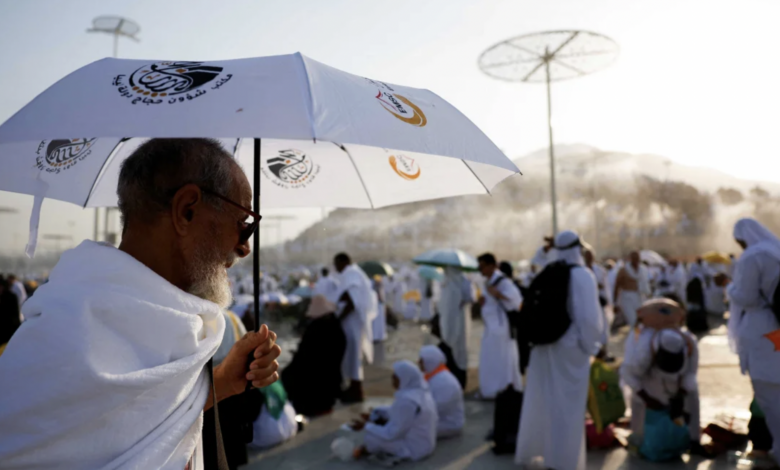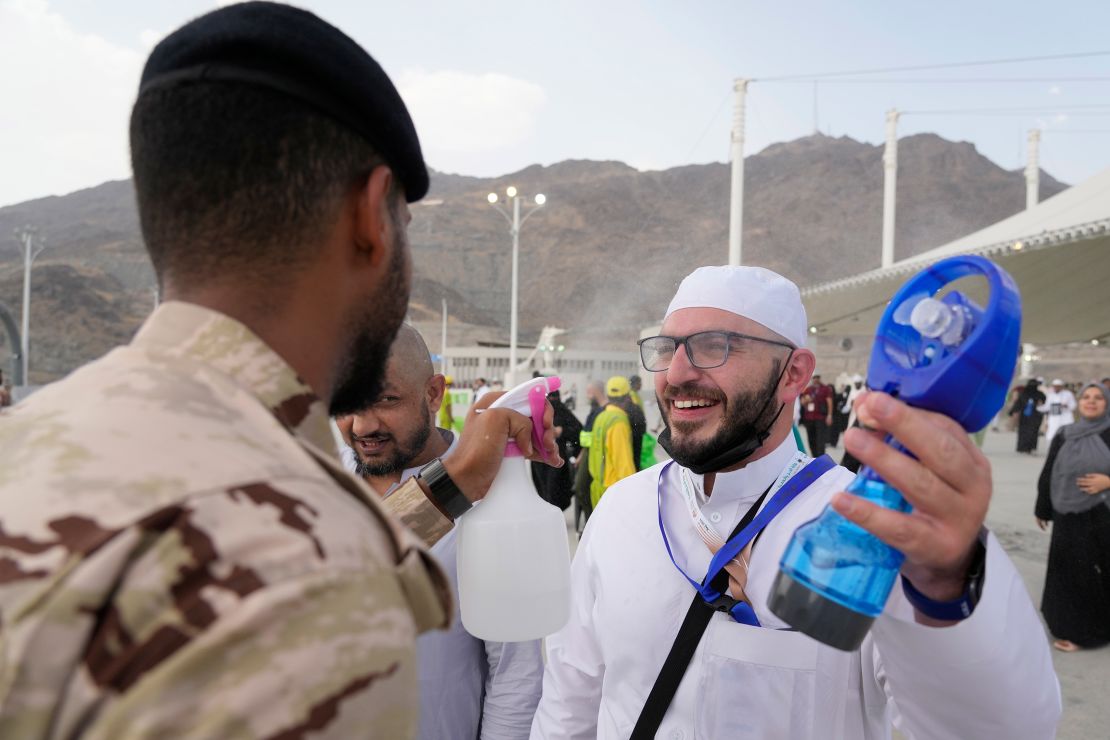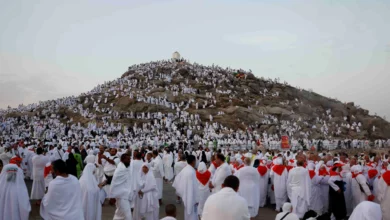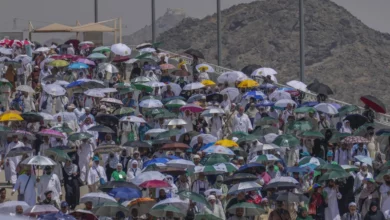
The official death toll from this year’s Hajj pilgrimage has soared to almost 500 and the true toll could be more than double that as reports emerged that as many as 600 Egyptian worshipers perished on the route to Mecca amid extreme heat.
At least 14 Malaysians, 165 Indonesians, 68 Jordanians, 35 Pakistanis, 35 Tunisians, 11 Iranians and 98 Indians have died, according to authorities in each country. A further 22 Jordanians are hospitalized and 16 are still missing, the Jordanian Foreign Ministry said.
Dozens of Iranians have also been hospitalized due to heatstroke and other conditions, the Iranian Red Crescent said Wednesday, according to Iran’s semi-official Tasnim news agency.
According to a CNN tally, this brings the latest official death toll for this year’s pilgrimage to at least 460.
The death tolls are expected to rise much further, as Saudi Arabia and Egypt have yet to release official figures. Additionally, the governments are only aware of pilgrims who have registered and traveled to Mecca as part of their country’s quota – more deaths are feared among unregistered pilgrims.
The pilgrims made this year’s journey in dangerously high temperatures of up to 49 degrees Celsius (120 degrees Fahrenheit).
According to the Egyptian presidency, the crisis unit will be headed by Prime Minister Mostafa Madbouly, and will “provide support for families of the deceased.”
Egyptian President Abdel Fattah el-Sisi has also instructed the unit on “speedy coordination with Saudi Arabian authorities to facilitate the return of the bodies” of those who died, the statement added.
The official number of dead Egyptians stands at 28, according to an Egyptian cabinet statement Thursday. However, it is being widely reported by Reuters news agency and other outlets that as many as 500 to 600 Egyptians perished on the route.
Egyptian officials said they were working to gather an accurate tally of victims and missing persons. The discrepancy stems from vast numbers of unregistered pilgrims who are not accounted for among those who have registered and traveled to Mecca as part of their country’s quota.
Thousands more have been treated for heatstroke after an estimated crowd of 1.8 million Muslims contended with the high temperatures.
The Saudi Ministry of Health implemented safety measures including cooling stations along the official route, and urged pilgrims to use umbrellas and stay hydrated, The Associated Press reported. Despite this, this year’s event was overshadowed by tragedy, raising questions over whether more could have been done to ensure people’s safety.
It also highlights the dangers posed for the many unregistered worshipers who want to fulfil their religious duty despite not obtaining a Hajj permit, and who don’t have access to the official facilities.

Malaysia’s Minister for Religious affairs, Dr Mohd Na’im Mokhtar, said most of its pilgrims died from “heart disease, pneumonia and blood infection,” according to state-run Bernama News Agency. The Bernama report did not specify if the dead were members of the country’s official Hajj delegation.
A spokesperson for India’s Ministry of External Affairs announced the death of the 98 Indian nationals on Friday, saying: “These deaths have happened on account of natural illness, natural causes, chronic illness, also old age.”
On Saturday, the day when Muslims gather at Mount Arafat and where the Prophet Mohammed is believed to have delivered his last sermon, six Indian nationals died amid extreme heat and another four died due to “accidents,” the spokesperson said, without giving further details.
This year’s Hajj fell in one of the hottest months in Mecca
Mecca’s average maximum temperature in June is nearly 44 degrees Celsius (111 degrees Fahrenheit). But this year Hajj pilgrims experienced unusually extreme heat, with temperatures soaring to 52 degrees Celsius (125.6 degrees Fahrenheit) on Monday.
The Saudi government said on Monday that more than 2,700 people had been treated for heatstroke. Meanwhile, hundreds of people have taken to social media to post about their loved ones being unaccounted for.
More than 1.8 million people are taking part in this year’s Hajj, one of the world’s largest religious gatherings, according to the Saudi General Authority for Statistics.
While deaths among pilgrims are not uncommon (there were more than 200 last year), this year’s gathering is being held amid particularly high temperatures.
Hajj season changes every year according to the Islamic calendar and this year it fell in June, one of the hottest months in the kingdom.
Saudi Arabia advised pilgrims against performing the “stoning of the devil” ritual between certain hours after temperatures reached an extreme 49 degrees Celsius (120 degrees Fahrenheit).
Hajj officials asked pilgrims to carry umbrellas and stay hydrated amid the harsh conditions while the Saudi army deployed more than 1,600 personnel with medical units specifically for heatstroke and 30 rapid response teams. Another 5,000 health and first aid volunteers took part.
Performing Hajj is one of the five pillars of Islam, which requires every Muslim who is physically and financially able to make the journey to the holy city of Mecca at least once in his or her life.
The pilgrimage includes numerous detailed rituals including wearing a special garment that symbolizes human equality and unity before God, a circular, counter-clockwise procession around the cube-shaped Kaaba building, and the symbolic stoning of evil.
A source of prestige and revenue
The Hajj is a source of prestige for Saudi Arabia’s king, who holds the title of Custodian of the Two Holy Mosques as the guardian of Islam’s holiest sites. But the pilgrimage is also a significant source of revenue for the Saudi economy.
Soon after King Salman bin Abdulaziz took power in 2015, Saudi Arabia launched a $21 billion project to expand the Grand Mosque in Mecca to accommodate 300,000 additional worshippers. A year later, then Deputy Crown Prince Mohammed bin Salman identified the pilgrimage as a key component of a plan to diversify the Saudi economy by 2030.
Experts say that with oil sales generating close to a billion dollars a day for the kingdom, the pilgrimage’s economic benefit is marginal by comparison. But its great, untapped potential could bring significant riches to the kingdom in the long term.
Pilgrimage revenues were forecast to average about $30 billion a year and create 100,000 jobs for Saudis when the kingdom attracted around 21 million worshippers annually during the 10-day Hajj as well as the yearlong Umrah pilgrimage, according to official data cited by Reuters. The government is targeting 30 million pilgrims by 2030.
This story has been updated with additional information. Edward Szekeres, Handi Alkhshali, and Aishwarya SIyer contributed reporting.




